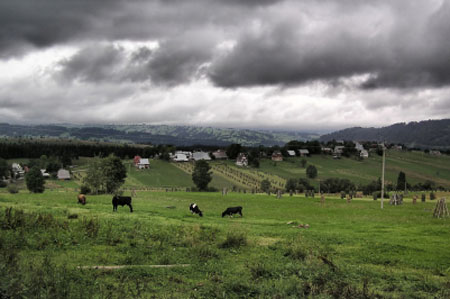 (Agrimoney) – Drier and hotter weather in the US, plus storms bringing hailstones “nearly the size of a softball”, wrought a surprise reversal in the condition of corn and soybean crops with ideas of dryness continuing to rise in some parts of the Midwest.
(Agrimoney) – Drier and hotter weather in the US, plus storms bringing hailstones “nearly the size of a softball”, wrought a surprise reversal in the condition of corn and soybean crops with ideas of dryness continuing to rise in some parts of the Midwest.
The proportion of the US corn crop rated “good” or “excellent” fell by 1 point in the week to Sunday, the first decline in five weeks to 75%, US Department of Agriculture data showed.
For soybeans, the proportion seen as good or excellent dropped by 2 points to 71%.
Although these ratings are still unusually high for the time of year, the falls defied market expectations of at least stable numbers, and potentially some increase, and helped soybean futures extend gains in early deals in Chicago, where the November contract was 0.7% higher at $11.15 a bushel.
“Although soil moisture levels are still good at lower levels, rain will soon be needed to prevent yield expectations from being revised downwards,” Commerzbank said.
‘In need of moisture’
The declines reflected the first spell of notably hot Midwest weather in a summer marked, so far, by mild temperatures, which have been ideal for corn pollination, a heat-sensitive process.
In Wisconsin, where the proportion of corn rated good or excellent sank by 4 points to 72%, scouted noted that “crops on light soils were in need of moisture”, as the proportion of soil rated short of very short of moisture tumbled 14 points week on week to 23%.
“This is the first time short soil moisture has climbed into the double digits this season,” the scouts said.
Further west, in South Dakota, ratings of both corn and soybean crops fell by 4 points, to 72% and 68% respectively, in a week which gave “very little rainfall”, although being accompanied by modest temperatures.
‘Hail nearly the size of a softball’
However, Brian Henry at Benson Quinn Commodities noted that the “current areas of concern are south western regions of the Corn Belt”, where southern parts of Illinois, one of the top producing states are “starting to get attention”.
In fact, Illinois crop ratings nudged higher last week.
But in southern neighbour Kentucky the proportion of corn rated good or excellent tumbled by 9 points to 66% good or excellent, and of soybeans by 11 points to 66, as the state suffered a cocktail of weather setbacks – ranging from temperatures in the middle 90s Fahrenheit ahead of “severe” storms.
“Portions of Lexington saw straight line winds around 95 mph, while one report from Leslie County measured hail at over 4 inches in diameter, nearly the size of a softball,” scouts said.
“High winds resulted in corn and tobacco being blown over in a few locations.”
However, “there were some reports of corn twisting due to lack of adequate rainfall”, while “some farmers reported soybeans are wilting in the afternoons and a few are replanting double crop soybeans”.
‘Dryness will build’
To the west, in Kansas, the proportion of corn rated good or excellent fell by 5 points to 59%, with the figure for soybeans dropping 6 points to 61%.
“Hot, dry conditions returned to Kansas, stressing crops in many areas,” scouts said, noting temperatures 2-6 degrees Fahrenheit higher than normal in most of the state, with some areas recording temperatures above 100 degrees.
And there are forecasts for a continued dearth of rainfall in the south western Midwest, where MDA forecast that “dryness will continue to build, especially in Missouri, south western Illinois and south western Kentucky.
“Dry conditions should continue in the drier areas in the six-to-10 day period,” before “notable improvements” in conditions in the second week of August.
‘Dry weather has arrived’
The drier weather has, however, proved helpful for US cotton crops, which thrive on drier and warmer weather, and had struggled somewhat with the cooler start to summer.
Signally, in Texas, the top cotton growing state, where corn and soybean condition both declined a notch, the proportion of the fibre rated good or excellent rose by 2 points to 39%.
“The majority of the state averaged no more than 0.5 inches in rainfall,” scouts said noting that some areas “experienced hot and dry temperatures with minimal moisture”.
In Arkansas, where the proportion of cotton seen as good or excellent rose by 4 points to 71%, one scout noted that “dry weather has arrived” but that “heat units are needed to mature our rice and cotton crops”.




